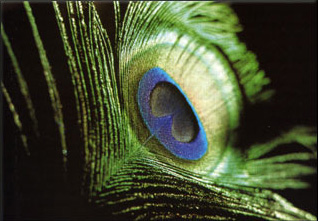

CS348B - Image Synthesis
John Pau
Date submitted: 18 May 2005
Description of the final results can be found here.
The iridescent colors of the peacock's tail feathers are the result of structural properties within the feather and not of pigments (although pigments are present). Varying densities of melanin granules layered within keratin causes thin film interference, which gives rise to the iridescence.
For my final project, I plan to model and render a peacock feather to capture this wavelength-dependent effect. One challenge to simulating thin-film interference on the peacock feather is that the feather cannot be treated as a uniform surface. The distribution of melanin layers, which influences interference, will need to be taken into consideration in order for the characteristic "eye" of the peacock to appear.
To account for this distribution, a texture will be used to control the reflectance properties at any given point within the "eye". The texture does not need to be a color image. A new Material class will need to be implemented to compute the scattering, and it is the computed scattered light that defines the coloring pattern of the "eye". The "eye" of the feather will be modeled as a disk placed near the edge of a cyclindrical stem serving as the feather's rachis. Each barb off to one of the sides of the stem will also be modeled using multiple thin cyclinders. The smaller barbule branches of the barbs will not be modeled. As such, the target viewing distance will be in the 1-3 ft. range. Due to the fact that iridescence is a viewing-angle dependent effect, at least two different viewpoints of the feathers will be provided to illustrate it.
The papers that I have read on feather modeling, include:
Due to time contraints, however, I do not plan to implement the l-grammar feather modeling approaches discussed in the papers. Instead, I will model the feather within a modeling program and import it into PBRT. The barbs at the tips of a peacock's feather are relatively sparse, so this should not be too labor intensive to be infeasible, although I do expect difficulties in exporting/importing the resulting model. Where the peacock feather has high geometric complexity is at the "eye", and this will region will be modeled by a roughly circular shape. If time allows, it may be helpful to add bump-mapping in this region to improve the visual appearance.
Other papers on rendering, particularly on thin-film interference, include:
Also, I have looked at the winning project of CS 348B 2001's rendering competition for reference. If you can suggest any other papers, particularly dealing with the rendering of interference colors, it would be greatly appreciated. Also, any further suggestions to my modeling approach would be very helpful.
 |
 |

(Description) |

(Description) |